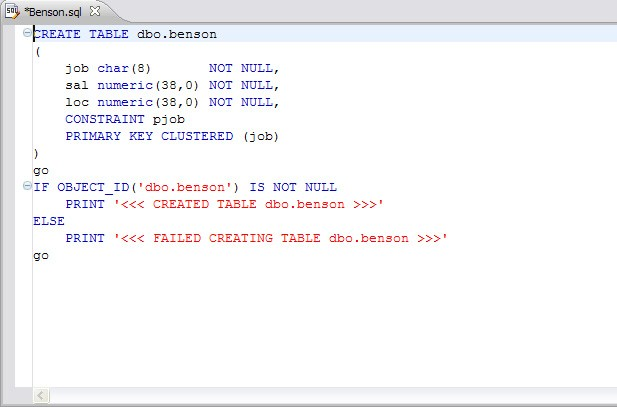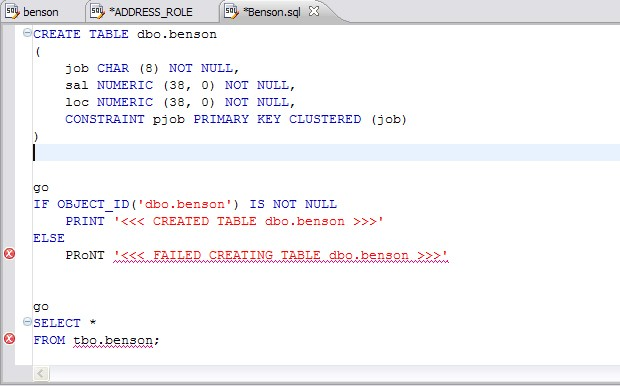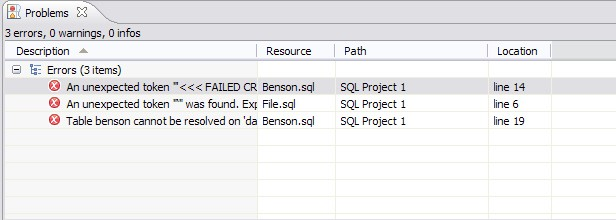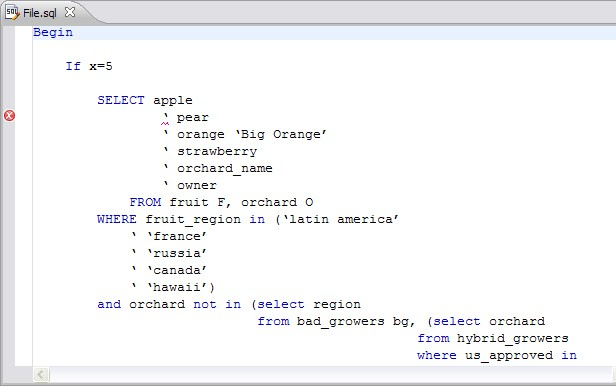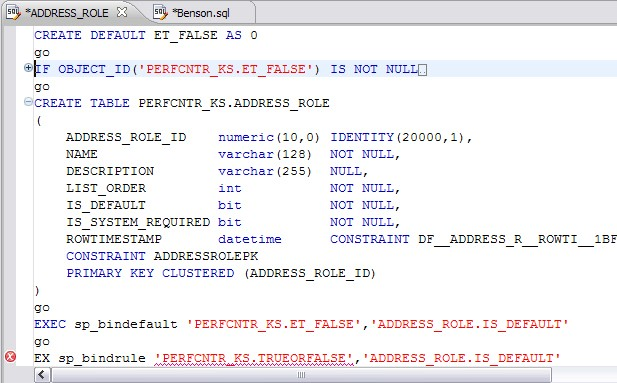Page History
...
Any number of instances of SQL Editor can be active on the Workbench at the same time. Multiple instances of SQL Editor displaying different content may be active on the same Workbench. These instances will be stacked, by default, but can also be tiled side-by-side, so the content of various files can be view simultaneously for comparison or multi-tasking purposes. When an instance of SQL Editor is active, the Main Menu contains commands applicable to the file format. If a view is active, SQL Editor commands are disabled automatically, except when commands are still valid between the selected view and the file displayed in the interface.
Among the commands SQL Editor supports via the right-click menu:
...
As you develop code in SQL Editor, it automatically detects semantic errors on a line-by-line basis. Whenever an error is detected, the line is flagged by an icon located in the left-hand column of the editor.
Additionally, all semantic errors detected in SQL Editor are displayed in the Problems view.
Right-click the error and select Go To in order to find the error. SQL Query Tuner opens and navigates to the specific line of code containing the specified error.
...
Code assist is available for SELECT, UPDATE, INSERT, and DELETE statements (and MERGE statements on SQL Server 2008 and above), as well as stored procedures, and functions (built-in and user defined.)
...
| Info |
|---|
Function suggestions are only available for Oracle and DB2 platforms. |
SQL Editor detects incomplete or erroneous code, processes the code fragments, and then attempts to apply the appropriate logic to populate the code.
...
| Info |
|---|
On a per platform basis, auto-suggestion behavior may vary. (For example, the WITH statement on DB2 platforms.) |
To modify object suggestion parameters, including setting it from automatic to manual, see Specify Code Assist Preferences.
...
| Custom Code Formatting Parameter | Value (if applicable) |
|---|---|
Stack commas separated by lists? | Yes |
Stack Lists with __ or more items. | 3 |
Indent Size? | 2 |
Preceding commas? | Yes |
Spaces after comma? | 1 |
Trailing commas? | – |
Spaces before comma? | – |
Right align FROM and WHERE clauses with SELECT statement? | Yes |
Align initial values for FROM and | Yes |
Place SQL keywords on their own line? | No |
Indent size? | – |
Indent batch blocks? | Yes |
Number of new lines to insert | 1 |
Indent Size | 5 |
Right Margin? | 80 |
Stacked parentheses when they contain multiple items? | No |
Stacked parentheses when the list contains __ or more items. | _ |
Indent size? | 5 |
New line after first parentheses? | No |
Indent content of conditional and looping constructs? | Yes |
Number of new lines to insert? | 1 |
Indent size? | 5 |
Custom code formatting example 2
...
SQL Editor features code folding that automatically sorts code into an outline-like structure within the editor window for easy navigation and clarity while developing code.
The editor window automatically inserts collapsible nodes in the appropriate lines of code for organizational purposes. This enables you to expand and collapse statements, as needed, while developing code in particularly large or complicated files.
...
Code quality markers provide annotations that prevent and fix common mistakes in the code.These These notes appear in a window on any line of code where the editor detects an error, and are activated by clicking the light bulb icon in the margin or by pressing Ctrl + l.
For example, if a statement reads select * from SCOTT.EMP, SCOTT.DEPT, when you click the light bulb icon or press Ctrl + l, a window appears beneath the line of code that suggests Add join criteria. When you click on a proposed fix, the statement is automatically updated to reflect your change.
...
Code Quality Check Type | Definition | ||
|---|---|---|---|
| Statement is missing valid JOIN criteria | If a SELECT statement contains missing join criteria, when it is executed, it can produce a Cartesian product between the rows in the referenced tables. This can be problematic because the statement will return a large number of rows without returning the proper results. The code quality check detects missing join criteria between tables in a statement and suggests join conditions based on existing foreign keys, indexes, and column name/type compatibility. Example: The following statement is missing a valid JOIN criteria: SELECT*FROM employeee,customerc,sales_orders The code quality check fixes the above statement by adding an AND clause: SELECT*FROM employeee,customerc,sales_orders
| ||
| Invalid or missing outer join operator | When an invalid outer join operator exists in a SELECT statement, (or the outer join operator is missing altogether), the statement can return incorrect results. The code quality check detects invalid or missing join operators in the code and suggests fixes with regards to using the proper join operators. Example: The following statement is missing an outer join operator: SELECT * FROM employee e, customer c The code quality check fixes the above statement by providing the missing outer join operator to the statement: SELECT * FROM employee e,customer c | ||
| Transitivity issues | The performance of statements can sometimes be improved by adding join criteria, even if a join is fully defined. If this alternate join criterion is missing in a statement, it can restrict the selection of an index in Oracle’s optimizer and cause performance problems. The code quality check detects possible join conditions by analyzing the existing conditions in a statement and calculating the missing, alternative join criteria. Example: The following statement contains a transitivity issue with an index problem: SELECT * FROM item i, product p, price pr The code quality check fixes the above statement with a transitivity issue by adding the missing join condition: SELECT * FROM item i, product p, price pr | ||
| Nested query in WHERE clause | It is considered bad format to place sub-queries in the WHERE clause of a statement, and such clauses can typically be corrected by moving the sub- query to the FROM clause instead, which preserves the meaning of the statement while providing more efficient code. The code quality check fixes the placement of sub-queries in a statement, which can affect performance. It detects the possibility of moving sub- queries from the FROM clause of the statement. Example: The following statement contains a sub-query that contains an incorrect placement of a WHERE statement: SELECT*FROM employee The code quality check fixes the above statement by correcting the sub- query issue: SELECT employee.* FROM employee (SELECT DISTINCT MAX(salary) col1 FROM employee) t1 | ||
Wrong place for conditions in a HAVING clause | When utilizing the HAVING clause in a statement: It is recommended to include as few conditions as possible while utilizing the HAVING clause in a statement. SQL Query Tuner detects all conditions in a given HAVING statement and suggests equivalent expressions that can benefit from existing indexes. Example: The following statement contains a HAVING clause that is in the wrong place: SELECT col_a, SUM(col_b) FROM table_a GROUP BY col_a HAVING col_a > 100 The code check fixes the above statement by replacing the HAVING clause with equivalent expressions: SELECT col_a, SUM(col_b) FROM table_a | ||
Index suppressed by a function or an arithmetic operator | In a SELECT statement, if an arithmetic operator is used on an indexed column in the WHERE clause, the operator can suppress the index and result in a FULL TABLE SCAN that can hinder performance. The code quality check detects these conditions and suggests equivalent expressions that benefit from existing indexes. Example: The following statement includes an indexed column as part of an arithmetic operator: SELECT * FROM employee The code quality check fixes the above statement by reconstructing the WHERE clause: SELECT * FROM employee | ||
Mismatched or incompatible column types | When the data types of join or parameter declaration columns are mismatched, the optimizer is limited in its ability to consider all indexes. This can cause a query to be less efficient as the system might select the wrong index or perform a table scan, which affects performance. The code quality check flags mismatched or incompatible column types and warns that it is not valid code. Example: Consider the following statement if Table A contains the column col int and Table B contains the column col 2 varchar(3): SELECT * FROM a, b In the above scenario, the code quality check flags the ‘a.col = b.col’ part of the statement and warns that it is not valid code. | ||
| Null column comparison | When comparing a column with NULL, the !=NULL condition may return a result that is different from the intended command, because col=NULL will always return a result of false. Instead, the NULL/IS NOT NULL operators should be used in its place. The code quality check flags occurrences of the !=NULL condition and replaces them with the IS NULL operator. Example: The following statement includes an incorrect col = NULL expression: SELECT * FROM employee The code quality check replaces the incorrect expression with an IS NULL clause: SELECT * FROM employee |
...
SQL Query Tuner provides code templates for DML and DDL statements that can be applied to the Editor via the (Ctrl + Spacebar) command. When you choose a template from the menu that appears, SQL Editor automatically inserts a block of code with placeholder symbols that you can modify to customize the code for your own purposes.
Code templates are available for DML, ALTER, DROP, CREATE, and platform specific commands.
A comprehensive set of DDL/DML templates are available, with statement alternatives varying by DBMS and specific DBMS versions. You can modify and create new templates via the SQL Templates panel on the Preferences dialog. See for more information on how to create and alter SQL code templates.
